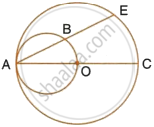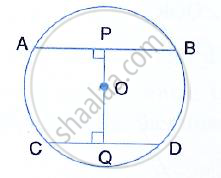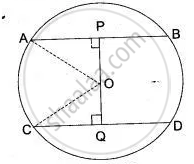Advertisements
Advertisements
Question
PQ and QR are two equal chords of a circle. A diameter of the circle is drawn through Q . Prove that the diameter bisects ∠ PQR.
Solution

Let QT be the diameter of ∠ PQR
Since , PQ = QR
∴ OM = ON
In Δ OMQ and Δ ONQ
OM = ON (equal chords are equidistant from the centre)
∠ OMQ = ∠ ONQ (90 ° each)
OQ = OQ (common)
Δ OMQ ≅ Δ ONQ (RHS)
∴ ∠ OQM = ∠ OQN (CPCT)
Thus QT i.e. diameter of the circle visects ∠ PQR.
APPEARS IN
RELATED QUESTIONS
A chord CD of a circle whose centre is O, is bisected at P by a diameter AB.

Given OA = OB = 15 cm and OP = 9 cm. calculate the length of:
(i) CD (ii) AD (iii) CB
In the given figure, AC is a diameter of a circle, whose centre is O. A circle is described on AO as diameter. AE, a chord of the larger circle, intersects the smaller circle at B. Prove that : AB = BE.

In the given figure, O is the centre of the circle with radius 5 cm. OP and OQ are perpendicular to AB and CD respectively. AB = 8 cm and CD = 6 cm. determine the length of PQ.

In the following figure, a circle is inscribed in the quadrilateral ABCD.

If BC = 38 cm, QB = 27 cm, DC = 25 cm and that AD is perpendicular to DC, find the radius of the circle.
A chord of length 8cm is drawn inside a circle of radius 6cm. Find the perpendicular distance of the chord from the centre of the circle.
Two chords of lengths 10cm and 24cm are drawn parallel o each other in a circle. If they are on the same side of the centre and the distance between them is 17cm, find the radius of the circle.
The figure shows two concentric circles and AD is a chord of a larger circle.
Prove that: AB = CD.
Two chords AB and CD of a circle are parallel and a line L is the perpendicular bisector of AB. Show that L bisects CD.
In Fig. O is the centre of the circle with radius 5 cm. OP⊥ AB, OQ ⊥ CD, AB || CD, AB = 8 cm and CD = 6 cm. Determine PQ.

AB, CD are parallel chords of a circle 7 cm apart. If AB = 6 cm, CD = 8 cm, find the radius of the circle.
